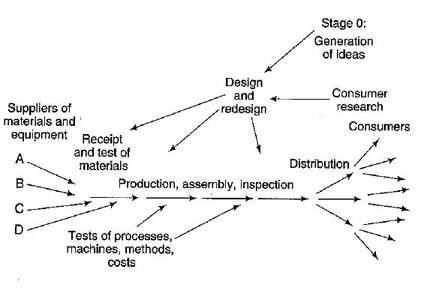Organizations can be considered as systems of processes whose aim is to achieve customer satisfaction by meeting and filling the needs of customers. The famous flow diagram of W. Edwards Deming, illustrated in figure 1, shows an organization as a system and illustrates how certain key processes fit together in a business to meet the needs of customers. A key point of Deming’s philosophy was that organizations should be appreciated and managed as systems of interconnected and interdependent processes.
 |
| Figure 1: Flow diagram of W. Edwards Deming |
Today, many companies that are focusing on continuous improvement are concerned with improving the processes in their system to reduce variation and waste. However, this may be a restricted view of continuous improvement—an argument can be made that managers should be equally concerned with mitigating and managing risk in their continuous improvement efforts.
…
Comments
J. M. Juran and Fitness for Purpose
While the author made some good points in the article, he failed to cite one of leading experts on this topic. For decades, Dr. Joseph M. Juran defined quality as meaning 'fitness for use.' The use is defined by the customers that purchase, use or are affected by the good or service. If an organization understands the needs of its many customers it should be able to design goods and services that are ‘fit for use.’ However, as more and more service industries use the methods of managing for quality the prior definition of quality is not applicable enough. We have settled on a new definition. Quality means ‘fitness for purpose’. This means no matter what you produce – a good or a service – it must be fit for its purpose.
You can read more about the how to understand and measure customer needs and value in upcoming 6th edition of Juran's Quality Handbook coming out later this year. For info, go to http://www.mhprofessional.com/product.php?isbn=0071629734.
J. Er Ralston
Juran Institute
www.juran.com
Add new comment